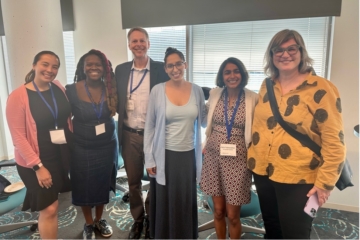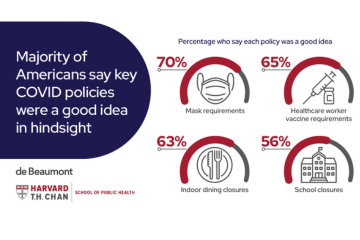
Photo courtesy: Centers for Disease Control and Prevention
Affordable and safe housing, accessible and safe public transportation, quality education, and many other factors help make our communities healthy. Recent events have increased awareness of the extent to which community conditions influence public health and well-being. Because of the interconnectedness of public health and other sectors — including transportation, housing, and education — public health workers frequently need skills that are often not taught in traditional public health education programs. They need broad-based leadership and management skills to build relationships and work across sectors.
In addition to the increasing need for broader skill sets, the public health workforce deals with constant turnover, including retirement of people in leadership roles. Recruiting and retaining talented staff can be challenging.
Many public health leaders are exploring ways to support future leaders who can address the mounting challenges ahead. Staff at the Centers for Disease Control and Prevention (CDC) are examining their leadership development initiatives to build a broad talent pool. In 2016, select leaders at CDC who had moved into supervisory leadership roles were interviewed about the factors they considered integral to their successful transition from a primarily technical role to a non-discipline–specific leadership role. These findings were published in the journal Public Health Reports.
Three top factors were found to contribute to a successful transition:
- Support from leadership throughout one’s career;
- The opportunity to lead an activity so as to demonstrate leadership beyond one’s scientific role; and
- Opportunities for new roles.
Staff transitioning to management roles need support from leadership, which includes receiving positive feedback from supervisors and notes of confidence about their abilities and growth. Managers are most effective when focusing on specific areas of excellence (for example, “The abstract you developed was clear, well–written, and encompassed the important points of the study”), as well as specific recommendations for how staff can continue to improve (such as “You don’t speak up much in meetings, and I know you have great ideas to offer. Be sure to voice your opinions more when you have something to contribute”).
Similarly, providing leadership activities and opportunities for staff to learn new skills or showcase their strengths is critical. Performance evaluation discussions can provide dedicated time for staff members and supervisors to discuss goals and objectives for professional growth. Through these discussions, supervisors can help staff members discover ways to lead activities and learn and demonstrate new leadership skills. Managers can point to activities that provide opportunities to learn new skills or showcase strengths in leadership, such as leading a publication, coordinating a workgroup, or chairing a committee. Other helpful support may include job sharing, shadowing, taking on short-term job positions in other departments, and encouraging employees to attend and present at professional conferences.
Mentorship is often mentioned in the context of important relationships that opened doors and provided crucial guidance. Mentorship isn’t formally provided in many public health organizations, but there are ways to incorporate mentorship into rated performance elements, making it fit into the broader organizational culture. Managers can help staff identify and maintain relationships with mentors on a casual basis, or create a formal program based on feedback from staff about successful mentoring relationships and programs in which they have participated.
The common factors expressed by leaders — hands-on exposure to leadership and growth opportunities coupled with leadership support — won’t be solely gained in a classroom course or a one-off activity. These forms of support must be provided early and often, created in a way that can evolve as needed, and be sustained over the long term. The strategies for leadership development identified here will not completely solve the recruitment and retention challenges facing public health agencies, but they can go a long way toward helping employees in their career development and fulfillment.
Alina L. Flores, DrPH, MPH is the Associate Director for Communications and Acting Chief for the Disability and Health Promotion Branch at the Centers for Disease Control and Prevention, National Center on Birth Defects and Developmental Disabilities, Division of Human Development and Disability. In these roles, Dr. Flores oversees communications work for the division, as well as the various disability and health-related work for the three teams within the Branch. Dr. Flores has been with CDC since 2001.
Ken Quintana is the Deputy Division Director in the Strategic Programs Office, located in CDC’s Human Resources Office. He oversees talent acquisition, workforce planning, succession planning, employee engagement, all human resources IT functions, and workforce data analytics for CDC. Before taking on this assignment, Ken was the deputy branch chief over the Workforce Engagement Branch in the Human Capital and Resources Management Office. He also led CDC University’s School of Leadership and Management Development, where he directed the leadership and management training curriculum for CDC. He has been with CDC for over 12 years.




